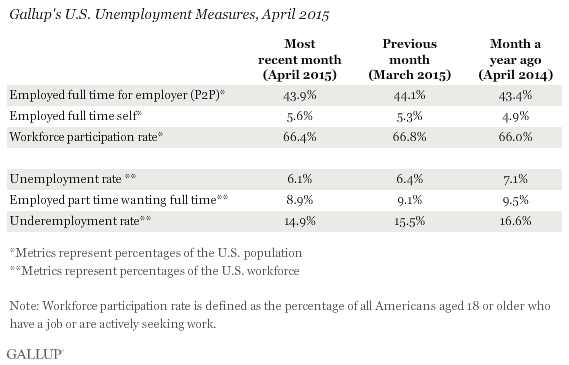U.S. Payroll to Population Rate 43.9% in April
Tuesday, May 12th, 2015
The U.S. Payroll to Population employment rate (P2P), as measured by Gallup, was 43.9% in April. This is up 0.5 percentage points from April 2014, though lower than what was found in April 2013. The metric has been fairly steady so far in 2015, and has not yet shown the typical seasonal rise in the spring months from lows in January and February.
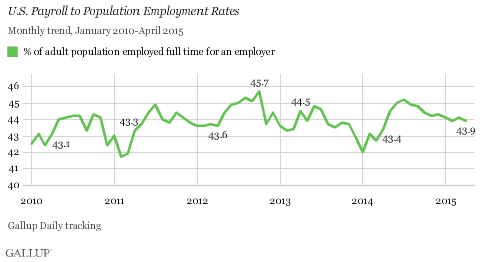
Gallup's P2P metric tracks the percentage of the U.S. adult population aged 18 and older who are employed by an employer for at least 30 hours per week. P2P is not seasonally adjusted. The latest results are based on Gallup Daily tracking interviews with 29,412 Americans, conducted April 1-30 by landline telephone and cellphone. Gallup does not count adults who are self-employed, work fewer than 30 hours per week, who are unemployed or are out of the workforce as payroll-employed in the P2P metric.
Overall, P2P is an important measure of the health of the economy; P2P tracks most closely with other objective measures of economic productivity such as GDP per capita, as well as with subjective measures such as life evaluations and physical well-being.
Workforce Participation at 66.4% in April
The percentage of U.S. adults participating in the workforce in April was 66.4%, on par with the 66.8% measured in March. The workforce participation rate has declined 0.6 points since February. Workforce participation measures the percentage of adults aged 18 and older who are working, or who are not working but are actively looking for work and are available for employment.
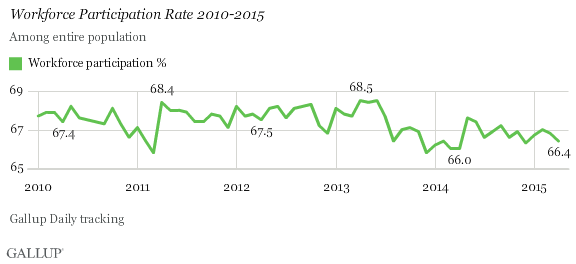
Since April 2010, the workforce participation rate has remained in a narrow range, from a low of 65.8% to a high of 68.5%. But since mid-2013, it has generally remained below 67.0%. Gallup began recording this metric in January 2010, but Bureau of Labor Statistics (BLS) figures prior to that show that labor force participation before the 2007-2009 recession was three percentage points higher than it is today, and it has yet to recover from that decline. The decline in workforce participation reflects, in part, demographic changes in the adult population as increasing numbers of baby boomers retire, but also lower rates of participation among those in their prime working years.
Unemployment Down to 6.1%
Gallup's unadjusted U.S. unemployment rate fell another 0.3 percentage points to 6.1% in April, the lowest rate measured in any April by more than a point since Gallup began tracking unemployment daily in 2010. Gallup's measure of unemployment has fallen a full point since its spike in January of this year. The low point in Gallup's five-year trend was 5.8% in December 2014. Gallup's U.S. unemployment rate represents the percentage of adults in the workforce who did not have any paid work in the past seven days, for an employer or themselves, and who were actively looking for and available to work.
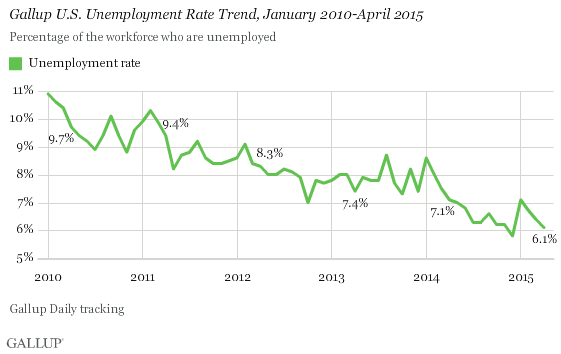
Unlike Gallup's P2P rate, which is a percentage of the total population, traditional employment metrics -- such as the unemployment rates Gallup and the BLS report -- are based on the percentage of the workforce. While both Gallup and BLS data are based on robust surveys, the two have important methodological differences. Additionally, the primary unemployment rate released by the BLS each month is seasonally adjusted. Although Gallup's employment numbers strongly correlate with BLS rates, the BLS and Gallup estimates of unemployment do not always track precisely on a monthly basis.
Underemployment Falls to 14.9%
Gallup's measure of underemployment in April is 14.9%, one of the lowest levels recorded since Gallup began tracking it daily in 2010. Gallup's U.S. underemployment rate combines the percentage of adults in the workforce who are unemployed (6.1%) and those who are working part time but desire full-time work (8.9%). This rate sums up to 14.9% in April due to rounding. The gradual decline in Gallup's underemployment measure has been driven almost entirely by a decline in unemployment. The percentage of the workforce working part time but wanting full-time work has varied narrowly between 10.1% and 8.4% since January 2010.
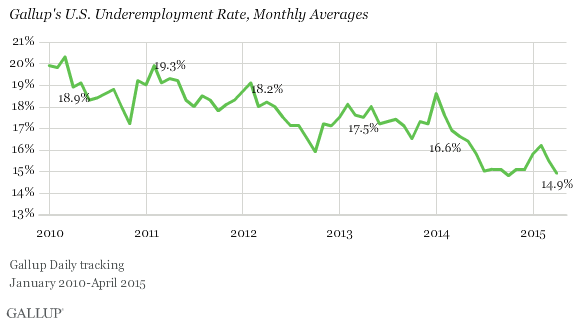
Bottom Line
Gallup's measure of unemployment continues to trend down. The decline in the unemployment rate has been accompanied by a slight rise in full-time employment, while part-time work has held relatively steady.
However, roughly half of the drop in the unemployment rate is due to people dropping out of the workforce altogether. This finding shows that unemployment is an imperfect measure of economic health: though the unemployment rate dropped, so did the overall employment rate as more people left the workforce. This underlying labor market weakness continues to act as a drag on economic confidence and slows the recovery almost six years after the economic recession ended.
The data in this article are available in Gallup Analytics.
